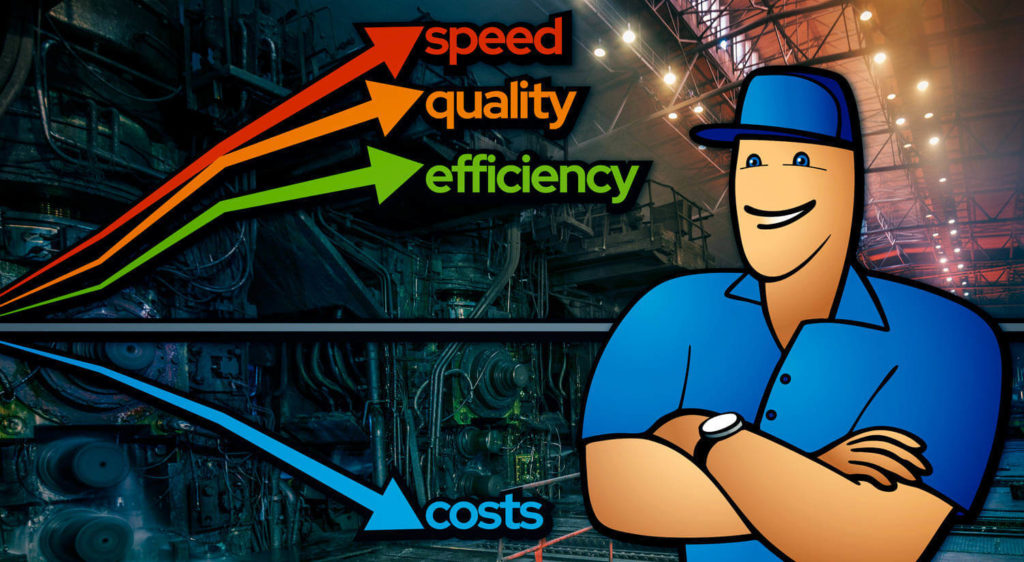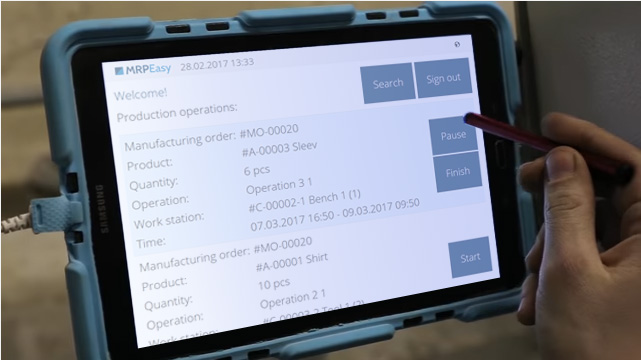What Is Agile Manufacturing?
Agile manufacturing is an approach to manufacturing that aims to increase product quality and service while reducing cost by implementing feedback-based design, planning, and production practices. Digital technology is at the heart of this modern manufacturing methodology.

What is Agile Manufacturing?
Agile manufacturing is a manufacturing methodology that lays out the processes and tools that help companies rapidly respond to changes in the marketplace without increasing costs or sacrificing quality.
Even though the term was already used at the start of the 1990s, agile manufacturing is really coming into its own now. That is because agile manufacturing is deeply connected to information technology, with ERP/MRP systems at the heart of the methodology. Up until 10 years ago, this kind of software was only available to large companies – the systems were expensive, required extensive training, on-premise servers and IT staff. Nowadays, manufacturers of any size can take advantage of affordable and easy-to-use cloud-based software systems that give them the opportunity to implement the agile approach.
In its essence, agile manufacturing is similar to lean manufacturing, as both concepts are geared towards increasing production efficiency, lowering costs, and increasing value. Agile manufacturing, however, is additionally focused on responding to customer needs and market changes quickly and effectively.
But purchasing an ERP/MRP package does not make a company agile. Instead, businesses have to modify their basic processes, firstly to accommodate the software, and then to prioritize product quality, production, and service while also increasing their capabilities for innovation and learning. To achieve this goal, feedback both from the system itself, from testers, and from customers must be constantly collected, analyzed, and put into practice.
Three components of Agile Manufacturing
In “Agile Manufacturing: The 21st Century Competitive Strategy”, Gunasekaran distinguishes between three interconnected elements of agile manufacturing.
Agile design
In agile manufacturing, a product is designed in iterations, taking customer requests as well as feedback from the system and the product testers into account, then refining the product, then getting feedback again, etc. Even though this process could be longer than in the case of regular product design, the repetitive cycle of improvement may drastically increase the final overall quality of the product. Of course, the duration of this process is heavily dependent on the complexity of the product. In addition, 3D printing can be used to reduce the duration of the design and prototyping process.
Agile planning
This is where a manufacturing ERP or MRP-system comes into play. When the product has been designed and its manufacturability has been verified, its bill of materials (BOM) and production process (routing) is laid out in the software. As a customer order is put into the system, it determines the material requirements, production costs, lead times, and the most viable time to start production while considering current inventory levels, staff availability, supplier lead times, etc. If a delivery of supplies is late, the system can use this feedback to reorganize the production schedule and provide another lead time for a customer order. All this ultimately provides manufacturers with tight-knit schedules for production and purchases, reducing lead times, increasing flexibility, and making the company more agile.
Agile production
Even though the most advanced agile manufacturers use autonomous systems such as artificial intelligence and robots in their process, agile production is also attainable without a lot of automation. Instead of AI figuring out the best way to do things, companies can monitor their processes, diagnose problems, and make improvements manually. This can be done with the help of a manufacturing execution system (MES) that collects feedback from the production floor, analyzes it, and turns it into easily understandable statistics and insights that allow for constant process improvement.
Production processes can also be improved and made more agile by providing better and more consistent training to employees. Some ERP/MRP systems also allow adding digital work instructions to manufacturing orders or to workstations, which can accelerate learning.
Who can benefit from Agile Manufacturing?
Even though agile may sound like a good idea to utilize in any manufacturing business, the methodology may not be compatible with every company. Here are some examples of where agile performs best:
- Businesses that operate in highly competitive environments where the smallest difference in quality or price can become the tipping point when a customer is weighing multiple options.
- Businesses that need to offer customization options to customers.
- Businesses that need to keep lead times short in order not to lose customers.
- Businesses that operate in well-developed local markets with large customer bases.
- Businesses that build products in small batches.
If one or more of these applies to your business, then agile manufacturing might be suitable for you. Companies that are looking to implement agile manufacturing should turn to specialized consultants that can give advice and provide a quicker and more efficient implementation process.
Agile Manufacturing and Mass Customization
Mass customization can often be an important part of agile manufacturing because it provides customers with many different customization options while still retaining quick service and high quality.
At its core, mass customization is a mix of mass production and make-to-order manufacturing. Companies that utilize this approach generally mass-produce different modules for the same essential product, then mix and match those modules according to the customer’s wish.
This method of mass customization is often complemented with a product configurator software that allows for the creation of matrix BOMs, where different parameters in the bill of materials can be modified to create an array of product variants.
For example, garment manufacturers need to offer different size and color variations, computer builders need to offer different specifications such as RAM and hard drive space, etc.
With an ERP or MRP system that offers product configuration as well as integrations with third-party eCommerce platforms, manufacturers can easily increase the agility of their business. This way, customers can configure their products in the web store and their customized orders can be turned directly into manufacturing orders for the specific product variant.
Read more about Mass Customization.
Key takeaways
- Agile manufacturing is a manufacturing methodology that lays out the processes and tools that help companies rapidly respond to changes in the marketplace without increasing costs or sacrificing in quality.
- Agile manufacturing is similar to lean, as both concepts are geared towards increasing production efficiency, lowering costs, and increasing value. Agile manufacturing, however, is additionally focused on responding to customer needs and market changes quickly and effectively.
- Agile manufacturing consists of agile design, planning, and production practices. This essentially means that everything is done in iterations, with constant improvements made according to the feedback accumulated at every step.
- Agile manufacturing is most beneficial to companies that operate in highly competitive environments where the smallest difference in quality, price, or service could mean losing or winning customers.
- Agile is complemented well by mass customization practices where modules of a product are made in bulk and then customized according to the customer’s wishes.
You may also like: Statistical Process Control – A Manufacturer’s Guide



